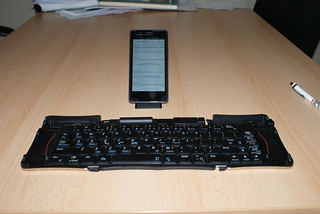As I wrote on Gopher, I have got a wireless keyboard (Bluetooth-compatible) – the Stowaway ThinkOutside Sierra. It’s externally almost identical to these ThingOutside keyboards which were designed to use with old good Palm handhelds (I personally have Palm III-compatible one but I’m not sure if there was version compatible with older Palm machines).
So it’s rather small and compact. The main difference is that there is no Palm-style connector. Instead there is a space for AAA battery and for Bluetooth electronics. The stand for the device is located at the bottom of the keyboard and it is used detached.
As I have the keyboard for just a few days but it seems that it have eaten my alkaline battery in two weeks (I have no idea if the battery was OK initially so I will have to investigate this issue a bit more).
The biggest issue of the keyboard probably is its glossy metal enclosure (every tap of finger is visible here). It’s not a problem during use as these parts are on the bottom (they are visible only when the keyboard is folded).
The size was ideal when if was new: it is just about size of a Zaurus PDA and just lightly bigger than a Palm III. However, my current device (bq Aquaris E4.5 Ubuntu Edition) is much more slim and it is not so wide.
The typing on the keyboard is OK. It is foldable and it has 3 hinges and these hinges havesome influence on keyboard stiffness (my Palm-compatible one is stiffer and it less deformed in the center – I assume that is is related to what this particular piece of keyboard was shored and handled in the past).
The keys have normal size and distances. They have a short travel when pressed but it is comparable with normal notebook keyboard (yes, old ThinkPad keyboard is better but not much). There is even a numeric row. So typing (even in an arcane language like Czech) is easy and comfortable. The only important missing key is Esc (Fn+Tab here) and the right Shift and Enter are alightly smaller than
usual.
Of course, the non-standard Esc is a problem for us, active vi/vim users…
I typed this text on that keyboard which was connected to by E4.5 phone without issues (no missing/doubled letters and so). The only problem is too agressive energy-saving policy (the interval to disconnect the keyboard is too short) but
it should be an issue of the phone OS (the OTA-13 Ubuntu update didn’t changed this behaviour, by the way).

